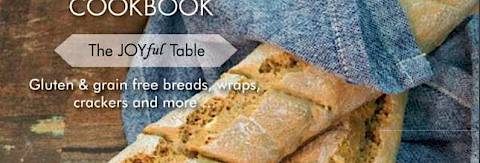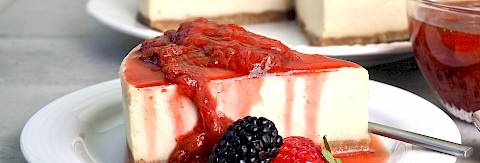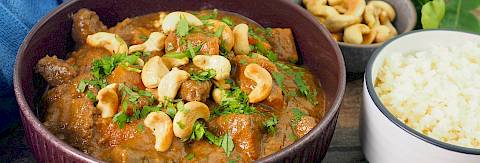
Raspberry Tea Cake
- Serves: 16 squares
- Prep Time: 00:10
- Cooking Time: 00:25
This is a delicious moist tea cake. It's not too sweet and has a hint of cinnamon and ginger. It's so quick to whip up and has a lovely light and soft texture, not dense like a lot of paleo cakes. It's the perfect cake for an afternoon tea party and is also yummy served warm with dairy-free cream.
Ingredients
* Please click on the green icon next to the ingredients listed below for extra details and helpful information.
- 2 Lge egg(s), room temperature
- 1/3 cup honey (unprocessed), runny
- 1/4 cup coconut oil, liquid
- 2 tsp vanilla extract (organic)
- 1 3/4 cups almond meal/flour
- 1/4 cup arrowroot flour, or tapioca can be used
- 2 tsp baking powder (gluten free)
- 2 tsp cinnamon
- 1 tsp ground ginger
- 1/4 tsp fine sea salt
- 140g (1 1/4 cups) frozen raspberries
Directions
Preheat oven to 170c (fan-forced). Line a 22cm square cake tin with baking paper (or a 27 x 17cm slice tin can also be used).
Add the eggs to a large bowl. Beat on medium using an electric hand-held mixer or stand mixer until the eggs are a cream colour, thick and the volume has increased.
Pour in the honey, coconut oil and vanilla. Beat into the eggs to combine well.
Add the almond meal, arrowroot, baking powder, cinnamon, ginger and salt. Beat to combine all the ingredients, scrape down the sides of the bowl with a spatula.
Gently stir in the frozen raspberries (if they are frozen in lumps make sure to separate the raspberries before adding).
Scoop cake mixture into the prepared tin and bake for 25 minutes or until just golden on top and firm to the touch (as the cake cools it will darken a little more on top).
Cool in the tin before removing with the assistance of the baking paper. Use a large knife to cut into 4 x 4 rows. (If you are serving the cake warm, cut while still in the tin and remove the slices with a metal spatula).
Store covered in the fridge if not eating on the day. This cake will keep for up to 3 days in the fridge and can be frozen for up to 3 months.
You may also like
egg(s)
I have used large free range or organic eggs from a 700g carton in my recipes. Eggs are one of the few foods considered to be a complete protein because they contain all 9 essential amino acids, also studies have shown that lutein (yellow colour) in egg yolks protects against the progress of early heart disease.
honey (unprocessed)
Use unrefined or raw honey. It is the most common natural sweetener in my recipes. It's best to buy local unprocessed honey as it has wonderful health benefits and can help with allergies. Generally honey sold in supermarkets has been processed. Honey possesses antiseptic and antibacterial properties.
coconut oil
Coconut oil is one of the most nutritious fats to cook and bake with. Use organic extra-virgin coconut oil which is unrefined and unbleached from non GMO coconuts. Coconut oil has a high smoking point and it is slow to oxidize due to its high saturated fat content, thus, resistant to going rancid. Some studies suggest coconut oil helps with digestion, including irritable bowel, tummy bugs, candida and parasites due to this oil containing short term medium-chain saturated fatty acids (MCFAs), which is a healthy form of saturated fat.
vanilla extract (organic)
Use an organic vanilla extract (not an essence) or vanilla powder. Vanilla makes a big difference to the flavour of a recipe, I recommend keeping to the quantities I have stated in a recipe. I prefer Madagascar pure vanilla extract manufactured by ‘Simply Organic’ and for powder, Vanillamax 100% pure, finely ground Madagascar vanilla beans produced by Bulletproof.
almond meal/flour
The most favoured gluten/grain free flour substitute in my kitchen is almond meal. It is finely ground blanched almonds and is also known as almond flour. It has a slightly sweet flavour so you don’t have to add as much sweetener when baking with it. Almond meal/flour is rich in manganese which helps the body heal after injuries and also helps the body break down carbohydrates. Almond flour is also rich in magnesium, which can help control your blood sugar levels. It's rich in vitamin E and other antioxidants, which may help reduce the risk of serious health conditions like cancer, diabetes, stroke, and heart disease. Almonds are also a good source of calcium.
All kinds of nuts can be ground down to make a meal and are excellent for raw cheesecake or pie bases. Nut meals/flours are best stored in airtight containers in the fridge or freezer to prevent them going rancid.
arrowroot flour
Arrowroot is a herb, the roots are cultivated for its starch properties. It is used in my recipes as a thickener and I also like combining it with almond meal to produce a much lighter texture, more like a gluten flour. I find the starch helps to bind the ingredients together. You can substitute tapioca flour, which is made from the dried roots of the cassava plant. Tapioca can be used in baking, it has a slightly sweet flavour. However, I do not recommend thickening with tapioca, as it has a stretchy, gummy texture. Supermarkets only sell in very small containers, which is not cost effective. Purchase from baking specialty stores, health food stores or online. ( When substituting for cornflour in recipes, 2 teaspoons arrowroot = 1 tablespoon cornflour/starch).
baking powder (gluten free)
Baking Powder is a rising agent for baked goods. If substituting for baking soda you will need 4 times the quantity. Ensure you purchase a gluten free, no aluminum brand. Alternatively, you can make your own baking powder; 1 teaspoon of baking powder is equal to 1⁄4 teaspoon of baking soda and 1⁄2 teaspoon of cream of tartar. Note, that they should only be combined when preparing your recipe.
cinnamon
I am sure you will notice as you read my recipes that cinnamon appears quite frequently. It lends itself to savoury and sweet dishes. I have used ground cinnamon in my recipes if not stated otherwise. The best cinnamon to use is Ceylon (Verum). It has huge health benefits in regulating blood sugar levels. Cinnamon has antifungal properties and candida (yeast overgrowth) cannot live in a cinnamon environment. Added to food it inhibits bacterial growth, making it a natural food preservative and these are just a few of the benefits.
ginger
Ginger root is widely used as a spice but also for medicinal purposes. It is a hot spice which you will find in many commercial curry powders. It's often used to prevent motion sickness and nausea. Some studies have shown joint swelling in people suffering with arthritis experience less pain and swelling when taken daily. I like to use fresh minced ginger in my meals and dry ground ginger in baked goods.
sea salt
Organic unbleached, unrefined organic Celtic sea salt or pink Himalayan salt is my salt of choice as these contain healthy minerals and trace elements that our body needs. Regular table salt has been bleached, refined and processed leaving minimal health benefits. If you choose to use regular table salt in my recipes you will need to reduce the quantity or the end result will be to salty.
raspberries
Raspberries are a perennial fruit with woody stems, they are cultivated to provide both fresh and frozen fruit. Raspberries spoil faster than most berries because of their delicate structure and hollow core. If frozen they will preserve for up to a year. Raspberries are usually quite expensive and purchased as a special treat. They are an excellent source of vitamin C, a source of folate and contain useful amounts of iron and potassium. High in fibre.
















